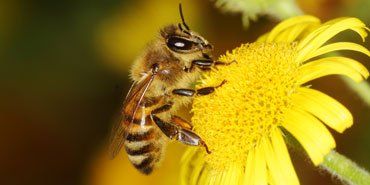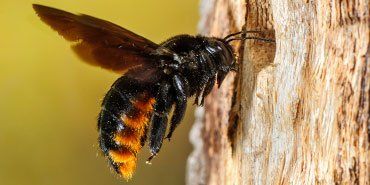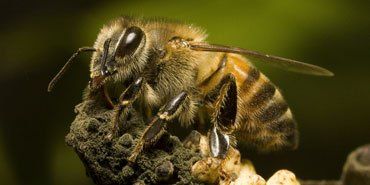Bee Pest Control & Removal
Griffin Pest Management Process
Always keep an eye open for unusually high numbers of active bees. This could mean that there are scouts looking for a new place to call home. If you find yourself with lots of bee activity, Griffin Pest Management uses different strategies to remove, relocate, and exclude bees.
Inspection
Our initial inspection process begins with a thorough inspection of your property that identifies what stinging insect you’re dealing with and develops a plan that effectively removes them from your property.
Treatment
Our treatment plan varies depending on the type of bee infestation you are dealing with. However, once problem areas are identified our trained bee exterminators will create an effective plan that targets the problem areas and effectively removes the beehive. Once the hive is removed, our state licensed construction team is available to repair any damage the bees caused to your property.
We also want to highlight that Griffin Pest Management does everything in their power to safely remove bees from your property. Bumble bees and honeybees are essential to our ecosystem and are beneficial pollinators. We recognize their importance and will do our best to preserve the bees as best as we can.
Exclusion
Our exclusion method involves sealing up areas of your property where bee nests could have formed. This method is effective at preventing unwanted beehives/bees from entering your property.
Follow Up
No matter what method we use, we will always do a proper follow up. If you are not satisfied with our services and would like us to come back, we will always come back and fix the issue. Are you in need of bee removal services? Call our number today!
Immediate Bee Removal
Identifying Types of Bees
Our professional exterminators are available to offer a free inspection that includes properly assessing the type of bees you’re dealing with. But, if you’re curious on how to identify different kinds of bees you are able to do so by looking at their appearance and the location of their hives.
Although bees can be a nuisance and are potentially dangerous, it is important to note that honeybees and bumble bees can be responsible for making your garden or crops flourish. This is why it is always best to leave bees alone and hire a trained bee exterminator to deal with bees. No matter what kind of bee you’re dealing with, Griffin Pest Management is here to help solve any bee related issue.
Social Structure and Life Span
How to Remove Bumble Bees and Honeybees
What Not to Do
As stated before, removing beehives can be dangerous without the proper knowledge, tools, and experience. We do not recommend trying to exterminate bees on your own. It is not only dangerous to you or your family, it is also dangerous to the innocent bees that are beneficial to our ecosystem. Even if you believe you’re dealing with carpenter bees, it is still always best to contact a professional to avoid harmful effects.
How to Prevent Bees
You don’t want to prevent the classic honeybee from pollinating your garden. That said, if you’re worried about a beehive forming, there are some precautions you can take to try.
To prevent carpenter bees: It is best to stain you wood. Carpenter bees prefer wood that is untreated.
To prevent honeybees: Honeybees are attracted to sugar. Avoid leaving out empty soda cans, or sweet juices. It is best to always take out the trash and keep your area free of trash and unwanted food.
Another tip is to burn a citronella candle to prevent bees because they do not like the smell.
Bees Found In Southern California
Africanized Bees
Africanized killer bees looks so much like a regular honey bee that the only way to tell the two apart is by measuring their bodies. Africanized bees have different wing measurements than honeybees.
Carpenter Bees
Carpenter bees look like typical bumblebees but often lack yellow stripes. They are solitary bees and will chew a tunnel into wood members to build a nest.
Honey Bees
Honey bees are social insects found all over the world. They are an extremely important beneficial insect because of their role in pollination. Honey bees pollinate more than 100 crops in the U.S.





